Saruq Al Hadid
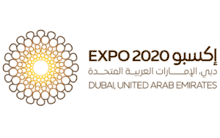
Saruq Al Hadid is an archaeological site in Dubai, United Arab Emirates (UAE), and stands as one of the most important and enigmatic historical sites in the country.[1]
It was a centre of constant human habitation, trade and metallurgy from the Umm Al Nar period (2600-2000 BCE) to 1,000 CE, when it was a major location for smelting bronze, copper and Iron.[2]
Arguably its most important period of flourishing was as a metallurgical centre in the Iron Age II period (1100-600 BCE). One of the many thousands of finds to be documented at the site was an ornate gold ring, which became the inspiration for Dubai's Expo 2020 logo.[3]
Some of the many enigmas surrounding the site are its location far from sources of water, ore or firewood, all critical elements to a metallurgical centre. An abundance of pottery and metal artifacts possibly identifying the site as a centre of snake worship have given rise to much speculation.
In all, over 12,000 unique objects have been unearthed at the site.[4] A number of key finds are on public display at Dubai's Saruq Al Hadid Archaeology Museum in Al Shindagha, housed in a traditional barjeel (wind tower) building constructed in 1928 by Sheikh Juma bin Maktoum Al Maktoum.[5]
The site, a millennia-old hub for manufacturing and trade, has been linked to Dubai's present role as a global trading hub.[6]
Discovery
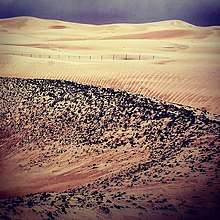
The site, now part of the Al Marmoom Desert Conservation Reserve was discovered in 2002 by Sheikh Mohammed bin Rashid Al Maktoum, Vice President and Prime Minister of the UAE and Ruler of Dubai, as he was flying across the desert in his helicopter. Noticing some unusual dune formations and a large black deposit in the sands, he reported the site to Dubai Municipality's Architectural Heritage and Antiquities Department, which carried out an initial survey under then-director, Dr Hussein Qandil. The site proved to be a field of waste, or slag, from copper and iron smelting. It was conjectured the extensive slag fired, measuring some 1.5 hectares, had stopped the sand shifting and blowing and so had preserved the underlying site.[1]
That first exploration yielded a horde of ceramics, beads and copper and bronze artefacts, including arrowheads, axe heads, a fish-hook, bracelets, knives and, intriguingly, models of snakes.
Five seasons of excavations led by Jordan’s department of antiquities followed, revealing “an extraordinary collection of Iron Age artefacts”. The survey work carried out at this time also unearthed the nearby Umm Al Nar site of Al-Ashoosh. This was followed by a series of digs carried out in 2008-2009 by the Dubai Desert Survey, a joint project between a group of American researchers and the Dubai Department of Tourism and Commerce Marketing.[1] This revealed that the site was not just an Iron Age settlement, but a multi-period site with distinct site functions spread over more than three millennia.[1]
The current director of fieldwork at the site is Dr Mansour Boraik, previously Director of Antiquities for Luxor in Egypt.
The most recent team to work on the site, from the University of New England (UNE), Australia, completed a three-year programme of archaeological fieldwork and post-excavation analysis in 2017.[7]
The site
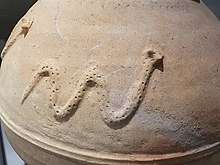
Located some 40km inland from the shore at Jebel Ali, the site is an enigma – the three requirements for smelting metals (water, fuel and ore) are lacking. It has been speculated that the site may have been chosen because of religious beliefs. Bronze snakes found at the site, as well as pottery decorated with snake motifs, provide some of the many mysteries of Saruq al-Hadid. In smaller numbers, these have been found elsewhere in the UAE and Oman, specifically at Qusais, Rumailah, Bithnah, Masafi and Salut,[8] but Saruq Al Hadid was either the main centre for production or was of great significance to what may have been a snake cult.[1]
Early eras at Saruq Al Hadid are represented by stone-lined hearths and ash-pits, as well as associated post-holes. A series of midden deposits containing large amounts of animal bone have supported carbon dating to the Umm Al Nar and Wadi Suq periods. Deposits of a large number of artefacts, thought to have been cached, have been dated to Iron Age I-II, with finds between 1.3-3 metres dated to Iron Age II. Surface deposits represent Iron Age II and later.[1]
A total of 223,889 bone fragments have been recovered from the site, from camel and oryx bones through to rodents, with widespread evidence of both hunting and husbandry and also hide processing. There are also a large number of saltwater fish bones, including whole fish bodies of bream, needlefish, emperor fish and grunt, which would point to the salting and preservation of fish at the coast before its transportation inland. This practice of salting fish for inland consumption was first observed at Mleiha.[1]
As well as bones of inland bird species such as quail, Socotra cormorant bones were also evident. Animal remains point to Saruq Al Hadid enjoying richer vegetation in the past.
Pottery finds point to Iron Age I and Wadi Suq links with Tell Abraq, Kalba and Shimal, as well as Muweilah and Bithnah, the latter also a site where snake motifs are notable on pottery.[9]
Decorative items from Saruq Al Hadid include metal and stone jewellery, as well as elaborate items carved from shell.[10]
Metallurgy
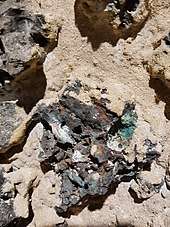
Widespread evidence for copper smelting at Saruq Al Hadid consists of slag, ingots and finished items, as well as copper scrap. While there have been finds at the site linking smelting to Wadi Suq objects, most evidence is of later origin, from the early Iron age through to the pre-Islamic period. [11] Finished copper items recovered from the site include extensive troves of weapons (swords, daggers, knives, axes and arrow-heads), as well as adornments and decorations – including snake figurines. While many items were made from very pure copper, traces of alloys have been found, including alloys of tin – which is not found naturally in Arabia and which must therefore have been traded from overseas. Finds of zinc-rich 'brass' have also been recorded.[12]
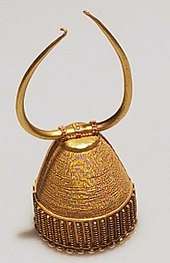
A number of bimetallic items, comprising ferrous and copper alloys, have been found at the site, with over 200 kg of ferrous remains in all – a significant quantity given the dearth of ferrous items recovered from other sites in the region. Despite the wide range of ferrous items recovered, there has been no sign of furnaces or iron slag at the site.
Major finds of gold at the site include base materials, including wire and strips, as well as finished items. These include beads and rings made from pure gold, gold sheet over silver alloy and lead.
Trade links
The 53 seals unearthed from the cite constitute the largest collection of Iron Age seals in the Arabian Peninsula and demonstrate links with Mesopotamia, the Indo-Iranian area and Egypt. Seals with distinctive patterns from 'Dilmun', as well as animal, figurative, crescent, pyramid and star patterns have been found and catalogued.[13] Finds of early Iron Age carved wooden artefacts at the site consist of local woods such as Acacia, Ghaf and Sidr, but also items made from olive and pine wood, which point to early trade links with the Levant.[14]
As well as evidence of metals from far afield (tin), carnelian beads point to links with the Indus Valley, while seals and pottery finds link to the Sumerians of Mesopotamia.
Museum
The Saruq al Hadid archaeology museum opened to the public in 2016 in the Shindagha district of Dubai, near Dubai Creek, inaugurated by Sheikh Mohammed.[15] Entrance costs Dhs20 (Dhs10 for children) and the museum is open Saturday & Thursday: 08:00am – 02:00pm and Sunday to Wednesday: 08:00am – 08:00pm.
See also
References
- 1 2 3 4 5 6 7 "Brushing off sands of time at the archaeological site of Saruq al-Hadid". The National. Retrieved 2018-09-06.
- ↑ "SHARP – the Saruq al-Hadid Archaeological Research Project". Research Plus. 2017-09-03. Retrieved 2018-07-29.
- ↑ "The story behind the new Dubai Expo 2020 logo - What's On Dubai". What's On Dubai. 2016-03-28. Retrieved 2018-07-29.
- ↑ Report, Gulf News Web (2016-11-04). "Know the UAE: Archaeological site found south of Dubai shows key aspects of life in Iron Age Arabia". GulfNews. Retrieved 2018-07-29.
- ↑ "Saruq Al-Hadid Archaeological Museum Official Website". Retrieved 2018-07-29.
- ↑ Mogielnicki, Robert. "Saruq Al-Hadid to Jebel Ali: Dubai's Evolving Trading Culture" (PDF). Gulf Affairs: 10–12.
- ↑ "SHARP – the Saruq al-Hadid Archaeological Research Project". Research Plus. 2017-09-03. Retrieved 2018-07-29.
- ↑ "The Snake Figuration in Iron Age Society" (PDF). Liwa. 5: 3. June 2011.
- ↑ Weeks, Lloyd; Cable, Charlotte; Franke, Kristina; Newton, Claire; Karacic, Steven; Roberts, James; Stepanov, Ivan; David-Cuny, Hélène; Price, David (2017-04-26). "Recent archaeological research at Saruq al-Hadid, Dubai, UAE". Arabian Archaeology and Epigraphy. 28 (1): 44. doi:10.1111/aae.12082. ISSN 0905-7196.
- ↑ Weeks, Lloyd; Cable, Charlotte; Franke, Kristina; Newton, Claire; Karacic, Steven; Roberts, James; Stepanov, Ivan; David-Cuny, Hélène; Price, David (2017-04-26). "Recent archaeological research at Saruq al-Hadid, Dubai, UAE". Arabian Archaeology and Epigraphy. 28 (1): 53. doi:10.1111/aae.12082. ISSN 0905-7196.
- ↑ Weeks, Lloyd; Cable, Charlotte; Franke, Kristina; Newton, Claire; Karacic, Steven; Roberts, James; Stepanov, Ivan; David-Cuny, Hélène; Price, David (2017-04-26). "Recent archaeological research at Saruq al-Hadid, Dubai, UAE". Arabian Archaeology and Epigraphy. 28 (1): 45. doi:10.1111/aae.12082. ISSN 0905-7196.
- ↑ Weeks, Lloyd; Cable, Charlotte; Franke, Kristina; Newton, Claire; Karacic, Steven; Roberts, James; Stepanov, Ivan; David-Cuny, Hélène; Price, David (2017-04-26). "Recent archaeological research at Saruq al-Hadid, Dubai, UAE". Arabian Archaeology and Epigraphy. 28 (1): 46. doi:10.1111/aae.12082. ISSN 0905-7196.
- ↑ DAVID-CUNY, Hélène; BORAIK RADWAN KARIM, Mansour; MAHMOOD, Ahmed; YUSIF AL-AALI, Yaaqub (2017-08-04). Iron Age Seals at Saruq al-Hadid (Dubai, UAE).
- ↑ Weeks, Lloyd; Cable, Charlotte; Franke, Kristina; Newton, Claire; Karacic, Steven; Roberts, James; Stepanov, Ivan; David-Cuny, Hélène; Price, David (2017-04-26). "Recent archaeological research at Saruq al-Hadid, Dubai, UAE". Arabian Archaeology and Epigraphy. 28 (1): 39. doi:10.1111/aae.12082. ISSN 0905-7196.
- ↑ Wam. "Shaikh Mohammed inaugurates Saruq Al Hadid museum". www.khaleejtimes.com. Retrieved 2018-07-29.